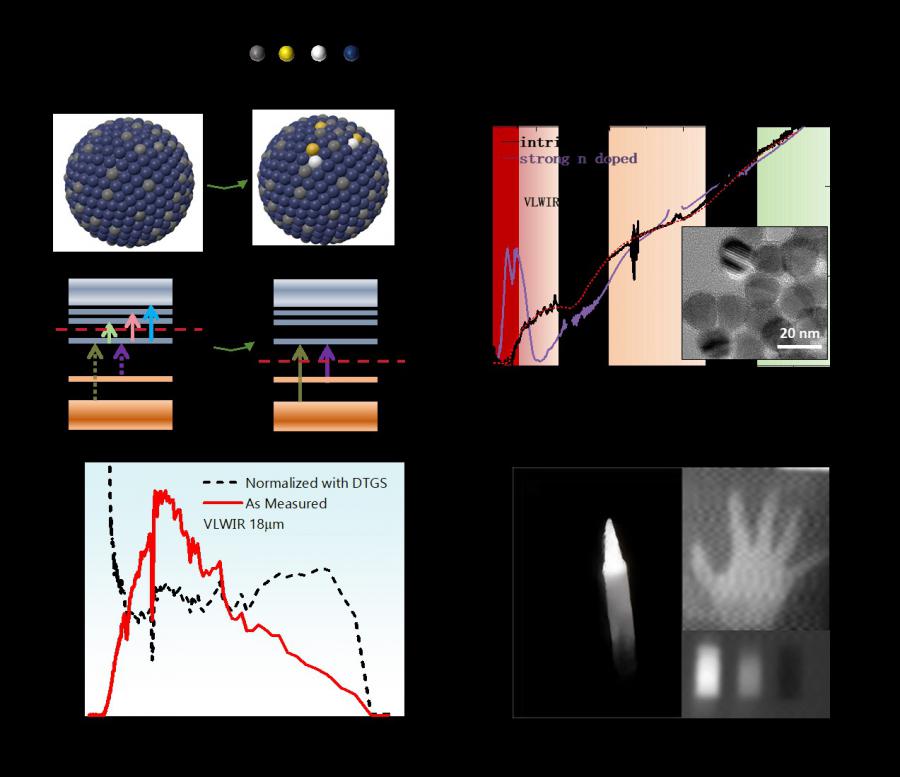
Very Long Wave Infrared Quantum Dot Photodetector up to 18 μm
USA, August 31, 2024 /EINPresswire.com/ -- Colloidal quantum dots (CQD) are of interest for optoelectronic devices because of the wide energy gap tunability from ultraviolet to infrared wavelengths. This work developed an ionic doping modification that demonstrated the upper wavelength limit for photodetection up to 18 μm on CQD. For 10 μm detector, the detectivity exceeds 109 Jones, with the responsivity of 0.13 A/W. This work is a step toward answering the general question on the CQD photodetection wavelength limitation.
Infrared spectra range matching with the atmospheric windows have attracted widespread research interest, widely used in remote sensing, environmental monitoring, and weather forecasting. According to the Rayleigh scattering law, scattering is inversely proportional to the fourth power of the wavelength. This implies that long-wave infrared (LWIR, 6-15 μm) and very long-wave infrared (VLWIR, 15-30 μm) have advantages on propagation distance. Currently, commercial LWIR or VLWIR detectors are based on expensive bulk epitaxial materials, requiring complex flip-bonding process to couple with the read-out circuit.
CQDs are a new type of semiconductor with high-throughput solution processing. Over the past decades, there is great progress on CQD infrared photodetection, like infrared camera, hyperspectral imager, bio-imaging and spectrometers. Although the absorption spectra of CQD already cover multiple spectral ranges from near infrared to terahertz, only very few CQD device could reach LWIR. Whether quantum dot photodetectors can reach the VLWIR region has yet to be demonstrated.
In a new paper (doi: https://doi.org/10.1038/s41377-024-01436-y ) published in Light Science & Applications, a team of scientists, led by Prof. Dr. Menglu Chen, from School of Optics and Photonics, Beijing institute of technology, China, have developed VLWIR and LWIR photodetectors with semimetal HgTe CQDs. The CQD spectral range is determined by the band gap of the respective compound according to the quantum confinement. They achieved large size HgTe CQD by re-growth method, with long-time stability up to several months in polar solution. This provides a good platform for ligands exchange. What’s more, surface ionic modification is developed to obtain precise doping as well as surface passivation to reduce mercury emission. The carrier mobility is improved by a factor of 100, improving the carrier transport efficiency. The thin film transistor and photoresponse experiment illustrate that the ratio between the carrier drift length and the electron channel length limited the quantum efficiency on device. Our treatments benefit 18 μm VLWIR CQD photodetector and 10 μm LWIR CQD photodetector with 100-time improved responsivity and specific detectivity.
“The proper ligands modification to achieve high mobility and decent carrier lifetime, is vital for long wavelength photodetection. ”
“This work not only expands the photodetection wavelength on CQD, but also motivates interest in bottom-up infrared photodetection beyond costly epitaxial growth semiconductor bulk.” They added.
DOI
10.1038/s41377-024-01436-y
Original Source URL
https://doi.org/10.1038/s41377-024-01436-y
Funding information
This work is supported by Westlake Institute for Optoelectronics (2024GD003), National Natural Science Foundation of China (62105022, U22A2081), Beijing National Laboratory for Condensed Matter Physics (2023BNLCMPKF012).
Lucy Wang
BioDesign Research
email us here
Distribution channels: Science, Technology
Legal Disclaimer:
EIN Presswire provides this news content "as is" without warranty of any kind. We do not accept any responsibility or liability for the accuracy, content, images, videos, licenses, completeness, legality, or reliability of the information contained in this article. If you have any complaints or copyright issues related to this article, kindly contact the author above.
Submit your press release
